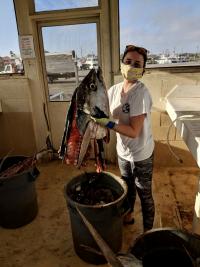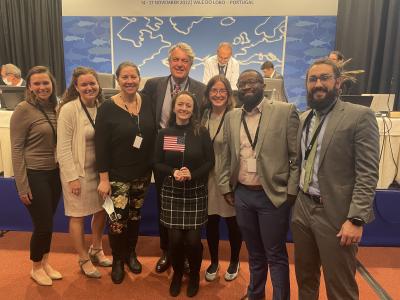It’s not often that a fish carcass changes the course of a career.
Then again, the bluefin tuna is a superlative fish. The first bluefin that Tyler Loughran encountered “was almost as big as I was and it wasn’t even full grown,” she said.
In December, four years after finding that fish, Loughran completed the John A. Knauss Marine Policy Fellowship Program a month early to take on a new role as a contractor with the National Oceanic and Atmospheric Administration. There, expanding on work that she began as a Knauss fellow, she will help develop an assessment of how highly migratory Atlantic species — like her tuna — might fare in a changing climate.
A Big Fish Story
Loughran was working as the manager of a fisheries laboratory at the University of Texas when she found her career-turning tuna carcass. The filleting station at the lab on the Gulf of Mexico usually turned up catfish and sheepshead. On one of her visits, though, a tuna trawler came ashore.

“I remember just looking at this fish and thinking, ‘This is awesome,’” Loughran said.
This massive fish, she knew, was perfectly adapted to its role as an apex predator.
“I’m looking at a ‘big cat’ of the sea,” she said.
This was a fish that tied together the world, literally. These tuna cross the breadth of the Atlantic Ocean in little more than a month, passing through waters governed by countless nations and territories. How tuna fare on our changing planet has existential implications for small island nations whose economies are focused on fishing. Here was a fish that stoked her intellectual curiosity.
“I really like complex issues,” Loughran noted, laughing.
Loughran had always been just as interested in international policy as hard science, and her supervisor, Brad Erisman, the life history program lead in the Fisheries Resources Division of NOAA’s Southwest Fisheries Science Center, laid out a potential path for her. The first step was to complete a master’s program at the Scripps Institution of Oceanography, then participate in the one-year Knauss fellowship. Sponsored by NOAA and the National Sea Grant College Program, the fellowship places students in federal government offices in Washington, D.C., where they learn about the national policy decisions affecting ocean, coastal and Great Lakes resources.
A Fitting Fellowship
Loughran’s graduate work at Scripps, completed in 2021, focused on Pacific bluefin tuna. She examined the species’ prospects as the climate warms, hoping to provide clearer predictions to the various policymakers who impact this fish.
It was fitting, then, that Loughran became the first Knauss fellow to work with NOAA’s deputy assistant secretary for international fisheries. There, among other projects, she led stakeholder listening sessions that brought together academics, Indigenous communities, resource managers and representatives from industries to discuss climate impacts on international fisheries. The experience pushed her to hone her communications skills and her eloquence as a facilitator.
“There are so many intricacies in fisheries management and international relations,” she said. “I’m really grateful for the opportunity to develop those skills.”

Deputy Assistant Secretary for International Fisheries at NOAA Kelly Kryc, who also served as Loughran's mentor, said she was "an extraordinary asset to the team right from the outset."
Kryc noted that two international fisheries commissions adopted climate-change measures that Loughran had championed at annual international meetings. That is “a huge accomplishment both for her professionally and for the United States,” Kryc said.
In November 2022, Loughran joined NOAA’s delegation at a fisheries meeting in Portugal, where she watched the issues she’d worked on for several years — climate change and highly migratory species — reach the global stage.
“That was a really special moment,” Loughran said. “I feel amazing to have this arc, from graduate school to sitting at this table in Portugal.”
Now that arc continues.
Officially an employee of Azura Consulting, Loughran is assisting NOAA’s efforts to develop comprehensive climate vulnerability assessment for highly migratory Atlantic species. The project is similar to her work as a graduate student, just “more evolved, more professional, and better informed,” she said.
“It’s the ideal position for me to be in after my fellowship,” Loughran said. “I get to learn from experts and maybe one day get to become an expert myself — I feel like I’m on that path.”
About California Sea Grant
NOAA’s California Sea Grant College Program funds marine research, education and outreach throughout California. Headquartered at Scripps Institution of Oceanography at the University of California San Diego, California Sea Grant is one of 34 Sea Grant programs in the National Oceanic and Atmospheric Administration (NOAA), U.S. Department of Commerce.